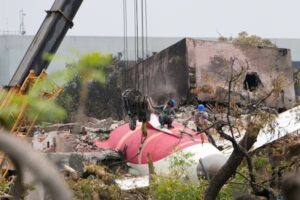What led to the crash of Air India? Investigators look for hints in “tail fire.”
The tail portion of the aircraft, which displayed indications of a “contained electric fire” but was limited to a few components at the back, is being extensively examined by investigators looking into the June 12 Air India plane disaster in Ahmedabad, according to The Indian Express.

Shortly after taking off from Ahmedabad, a Boeing 787-8 operated by Air India on its way to London Gatwick crashed into a medical hostel complex, killing 241 of all 241 people on board. 19 more individuals died on the ground as a result of the collision and the explosion that followed.
The post-crash explosion and gasoline fire that had scorched the remainder of the aircraft’s body had little effect on the tail part, which was stuck on the hostel mess’ roof.
According to officials quoted by The Indian Express, the black back box, also known as the aft Enhanced Airborne Flight Recorder (EAFR), which was discovered on the rooftop, had sustained significant interior thermal damage.
After a month, the Aircraft Accident Investigation Bureau published a preliminary summary of the investigation into the incident, noting that the “damage was extensive” and that data from the EAFR “could not be downloaded through conventional means.”
The preliminary analysis states that when the fuel control switches, which control the fuel flow to the engines, changed from the “run” to the “cutoff” position in less than a second, both engines lost power nearly simultaneously.
According to officials quoted in the newspaper, the aircraft’s tail sustained the anticipated crash impact when it collided with the hostel mess building, but they also stated that this was not the uncommon type of damage where the rear black box (aft EAFR) should have been irreparably damaged. Two black box sets are standard on the B787 aircraft model; one is located in the tail area and the other beneath the cockpit.
Investigating whether the electric fire in the tail was caused by a malfunction that started in one of the flight components before it started rolling for takeoff or if it was just a fire after the collision is necessary. According to the official, the fire was contained in the tail part and did not extend to the building or its electrical framework, even though it was embedded in Building A (the hostel mess).
The Indian Express claims that this is significant because the crew of the previous flight, AI-423, from Delhi to Ahmedabad, noted the status message “STAB POS XDCR” (Stabilizer Position Transducer, a sensor in the tail) in the technical log and filed a Pilot Defect Report. Before approving the flight for AI-171 at 12:15 p.m. on June 12, the Ahmedabad Aircraft Maintenance Engineer troubleshooted this.
“Any electrical system issue that started before the flight took off may have disrupted the interconnected flight sensors and, in a domino effect, sent the flight’s ECU (Engine Control Unit) the wrong data, cutting off the fuel supply. In order to have additional power during takeoff on a hot day in Ahmedabad, the APU also initiated an automatic logic start when the fuel supply switched back to “Run” from “Cut-off,” the official stated.
What the probe report said
According to the AAIB’s first report, the accident was caused by fuel being turned off to both engines soon after takeoff, with fuel control switches discovered in the “cutoff” position.
According to the AAIB, there was a one-second lag between the Air India plane’s engine 1 and engine 2 fuel cutoff switches switching from the RUN to the CUTOFF state. One of the pilots may be heard asking the other why he shut off in the voice recording from the cockpit. In response, the other pilot said he didn’t.
A month after the catastrophe, the 15-page report was released. It was the first formal description of the deadliest aviation mishap to hit India in decades.
The Indian Airline Pilots’ Association has refuted media stories that attribute the incident to human error. Pilots are skilled professionals who, with commitment and respect, bear the burden of hundreds of lives.
“Until their very last breath, the crew of AI 171 did everything they could to keep the passengers safe and reduce damage on the ground. ALPA India said in a statement that they should be treated with dignity rather than subjected to baseless character assessments.









